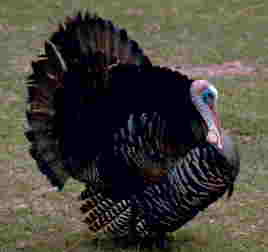|
Hurray! It's Thanksgiving. Totally Terrific Turkey Trivia (How's that for silly alliteration?) |
- Turkeys originated in North and Central America, and evidence indicates that they have been around for over 10 million years.
- The American Indians hunted wild turkey for its sweet, juicy meat as early as 1000 AD. Turkey feathers were used to stabilize arrows and adorn ceremonial dress, and the spurs on the legs of wild tom turkeys were used as projectiles on arrowheads.
- The Dine people tell of an enormous hen turkey that flew over their fields bringing them corn and teaching them how to cultivate their crops. The Apache Indians considered the turkey timid and wouldn't eat it or use its feathers on their arrows.
- The turkey's scientific name is Meleagril gallopavo (mel-e-AY-gril gal-low-PAY-voe) from Latin gallus, meaning cock, and pavo, meaning chickenlike.
- Benjamin Franklin was unhappy when the bald eagle was chosen over his proposed "original native" turkey as a national symbol. He said the turkey is a more respectable bird and a true original native of America.
- Until 1863, a Thanksgiving Day had not been celebrated annually since the first feast in 1621. This changed in 1863 when Sarah Josepha Hale convinced Abraham Lincoln to set aside the last Thursday in November "as a day for national thanksgiving and prayer."
- In the wild, turkey hens lay a clutch of 10 - 14 eggs. They lay one each day.
They incubate them by setting on them for 28 days. The size of the clutch is usually the number of eggs
that the hen can cover completely when setting on them.
- Turkey eggs are pale creamy tan with brown speckles, and twice as large as chicken eggs. They hatch in 28 days.
- A baby turkey is called a poult and is tan and brown.
- Domesticated turkeys (farm raised) cannot fly. Wild turkeys can fly for short distances at up to 55 miles per hour.
Wild turkeys are also fast on the ground, running at speeds of up to 25 miles per hour.
Wild turkeys can glide as far as a mile without fluttering a wing.
- A large group of turkeys is called a flock.
- The record-sized adult male wild turkey was 38 pounds, according to the National Wildlife Turkey Federation.
- Wild turkeys are omnivorous. They eat acorns, hazel nuts, pinon seeds and other nuts.
They also eat berries, roots and seeds. Turkeys even eat snakes, frogs and salamanders!
-
Turkeys have between 5,000 and 6,000 feathers in patterns called feather tracts.
- Only male turkeys (toms) gobble; females (hens) make a clicking noise. The gobble is a seasonal call during the Spring and Fall. Hens are attracted for mating when a tom gobbles. Wild toms love to gobble when they hear loud sounds or settle in for the night.
- Turkeys have great hearing, a poor sense of smell, but an excellent sense of taste.
They can also see in color, and have excellent vision and a wide field of vision (about 270 degrees).
- Farm raised turkeys are fed a diet of corn and soybean meal mixed with a supplement of vitamins and minerals.
On average, it takes 75-80 pounds of feed to raise a 30-pound tom turkey.
- The Guinness Book of Records states that the largest dressed weight (cooked, with dressing)
recorded for a turkey is 39.09 kg (86 lb.) on December 12, 1989.
- The heaviest turkey raised weighed 86 pounds.
- United States turkey growers raised over 271,676,000 turkeys in 2007.
- A 16 week old turkey is called a fryer. A five to seven month old turkey is called a young roaster.
A yearling is a year old. At 15 months of age a turkey is mature.
- The turkey trot is a form of ballroom dancing.
- Vincent Pilkington of Cootehill, County Cavan, Republic of Ireland,
plucked a turkey in 1 minute 30 seconds on November 17, 1980.
He also plucked 244 turkeys in 24 hours to raise funds for his local Holy Family School.
- It is estimated that more than 46 million turkeys are cooked and eaten during Thanksgiving in 2006
- The average weight of turkeys purchased for Thanksgiving is 15 pounds.
- A 15-pound turkey typically has about 70% white meat and 30% dark meat.
- Americans feast on approximately 535 million pounds of turkey on Thanksgiving.
- Ninety percent of American homes eat turkey on Thanksgiving. Fifty percent eat turkey on Christmas.
- A turkey sandwich is the most popular way for Americans
to prepare the fowl, accounting for 44 percent of consumption.
- North Carolina produces 61 million turkeys annually, more than any other state.
Minnesota and Arkansas are number two and three.
- When U.S. astronauts Neil Armstrong and Edwin Aldrin sat down to eat their first
meal on the moon in their historic 1969 voyage, their foil food packets contained roasted turkey and all the trimmings.
- The United States is the top Turkey Consumption Country with 17.9 pounds per capita in 2000.
Click on the wild turkey to go to the Thanksgiving Fun Internet Scavenger Hunt's first question.
Internet Hunts / Nature / Water Study Unit / Fields & Meadows EcoStudy Unit / Civics & History / Puzzles & Projects
November Internet Hunt / November Civics Internet Actvity / Exploring Native Americans / Outstanding Native Americans
Plants and People / Computers / Site map / Home
All trademarks, copyright and logos belong to their respective owners.
Updated 10/25//2016 ©1998 Cynthia J. O'Hora All Rights Reserved.

